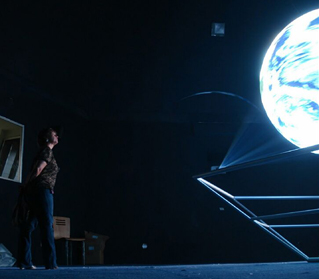|
|
|
|
General Requirements and Setup Information

The goal of this document is to describe a typical setup for Science On a Sphere and discuss very generally, the lessons learned while using Science On a Sphere in conferences, conventions, classrooms and presentations.
Sphere
The sphere size is 68" in diameter. Other sphere sizes are possible, but would require custom engineering (at additional cost to the SOS recipient). Description follows: The 68" sphere is built to come apart at the equator in two equal halves. There is one seam to hide and it's a very straightforward process to hide it. The 68" sphere is the sphere that we typically use for shows, conferences and conventions. The current version of these spheres weighs in at less than 50 pounds. The sphere is attached to the ceiling or suspension structure via a three-point suspension system. The cables are rated to hold many times the weight of the sphere. A three-point suspension system is used to hold the sphere in place and reduce lateral movement. If the sphere moves, then the images become un-focused. The cables are strong, yet small enough to blend into the background. The suspension cables come with the sphere.
Sphere Placement
The sphere is positioned within an enclosure, surrounded by four video projectors. The locations of the projectors form a square footprint around the sphere. The distance of the projectors from the center of the sphere is based on the projector lens characteristics, but generally can be at a distance of 16' to 21'.
Looking down from above, the sphere sits in the center of a a square box that can be formed by drawing lines between each adjacent projector. If "D" is the distance from the center of the box to a projector, then the lengths of the sides of this box can calculated by the formula: 2 x D / sqrt(2). It's important to realize that the distances are to the projector lens, often times the depth of the projector needs to be accounted for when fitting the projectors into a corner or other tight space. See the floor plan diagram (pdf) of the Science on a Sphere.
Projector Placement
As described, the projectors are at the corners of a virtual box with the sphere at the center. It is critical that the projectors are located at 90 degree angles from each other, relative to the center of the sphere. The projectors should be mounted in a way that allows for a 3-axis adjustment (x, y, z planes). In our lab and at most sites, we have successfully used standard projector mounts from Chief and Premier. The mounts can either be attached to a pipe coming down from the ceiling, a floor mounted truss, or attached to a wall (wall mounts are the last choice since it is easy to get projector vibration from wall mounts).
The projector height needs to be equal to the height of the equator of the sphere, plus or minus 12" or so (please talk to NOAA before making assumptions about the projector height). It is critical that the projector all be on the same geometric plane and that the projector plane be parallel to the floor.
Please look carefully at the floor plan diagram (pdf) of the Science on a Sphere.
Sphere and Projector Height
The height of the sphere is somewhat arbitrary however there are some best practices that should be followed. We have found through our numerous demonstrations, that the height at the equator of the sphere should be about 86" off the ground. This serves two goals, the first being, that that the projectors are also 86" off of the ground and this height somewhat minimizes the shadows that occur when an individual walks directly in front of a projector. This is clearly dependent on the height of the individual and their closeness to the sphere. The other goal served, is that the sphere isn't too high for viewers. By stepping back 4 to 8 feet, the viewers can still get a view of the northern part of the sphere, yet it's not so high as to not allow a viewer to walk up very close to the sphere and get a feeling of size, scale and proportions of the globe.
Audio System
It is generally recommended to have an audio system installed for SOS. There are audio components that include a mixer and a wireless mic. Out near the sphere, there are usually ceiling mounted / wall mounted speakers. The audio system is used to play audio tracks that accompany the sphere visualization and for a microphone system.
Sphere Viewing Considerations
The four-projector design of Science On a Sphere has some inherent limitations, the main one being the blackout areas at the top and bottom of the sphere. The blackout area amounts to a small square at the very bottom and very top of the sphere. This is the area where the light rays of projectors cannot reach from their current location. With the sphere at the recommended height, this blackout area is difficult to see and is generally of little issue even if someone happens to lean over and see the little blank area at the bottom.
Light Levels
We don't have a lot of information on acceptable light levels for Science On a Sphere viewing. Any discussion regarding acceptable light levels is fairly subjective. The projectors that are used are bright, 3300 lumen projectors. The projectors provide significant amount of illumination and contrast, even in well-lit areas, however being able to control some aspects of the light conditions in the enclosure will be important. The system looks it's best when viewed in fairly dark conditions, one in which the sphere appears to be suspended in outer space. The system has been setup in at least one lobby, but there was minimal outside light. At one conference we attended, the area around the sphere was flooded with high levels of ambient light, from high ceiling mercury vapor lamps and the system still looked very sharp and attracted a constant stream of spectators. In terms of direct outside light from the Sun, hot spots, sections or spots of light directly on the sphere may be very distracting to the viewers. Keeping direct light off of the sphere surface is important. For those that have seen the Science On a Sphere at NOAA in Boulder, we have some Exposure Values (EV) taken from a Gossen Luna Pro Digital light meter, set to ISO 100 (it's the best that we could do for the time being): Near the sphere, lights on: EV 2.2 to 2.8 Reflected light coming off of the sphere: EV. 6.3
System Noise and Cooling of Equipment
The projectors generate a small to moderate amount of noise due to the cooling fans. The projectors also generate a fair amount of heat for their size. The projector enclosure will have to maintain adequate cooling and ventilation for the projectors. The Dell computer systems generate very little noise, but a significant amount of heat from rear exhaust fans. The standard configuration consisting of two computers needs to be kept at an ambient air temperature somewhere below the mid 70's with adequate air flow away from the CPU cases.
Floor and Seating
A carpet floor would be desirable for kids to sit down on and to help reduce sound echoes. Many times, when children come in for a field trip or are there as part of a tour, they immediately sit down on the floor. Generally presentations led by a facilitator involve the audience walking around the sphere. However, some audiences don't want to walk around the sphere and are content to just stay in one place. In several venues, we have had people that just come in and find a place to sit (usually on exhibit furniture). It might be nice to accommodate a few places for folks to sit down in chairs or benches even though these audience members won't get the same, rich experience.
Walls
There might be an advantage to having some kind of smoked glass mirror on the inside of the enclosure. At one of the venues, we had a room that had T.V monitors and a wall of glass bookcases. Seeing the sphere reflected off the glass bookcases was very spectacular and seeing the sphere reflected in the curved glass of the black, powered off T.V. screens was even more amazing to see.
Audience
Over the past year, Science On a Sphere has been seen by thousands of individuals, from young children in grade school to adults. The venues have ranged from very casual to extremely structured. In all cases, a narrator-based approach has been used to show Science On a Sphere. Results with this presentation method have been extremely positive. The space setup is generally in a 30' x 30' enclosure, sometimes open on the sides in the case of our traveling exhibit or closed in the case of smaller rooms we've used. During presentations, having an audience of about 30 people is optimal. Audiences of 50 to 70 become uncomfortable, but they are also manageable with proper assistance for crowd control. During presentations, the facilitator can use a remote control device to manipulate the animations being shown on the sphere. The remote control can perform standard VCR like functions such as stop, play, fast-forward, reverse, etc. On some visualization, the remote control can be used to dynamically change the angle and tilt of the display to focus audience attention on a particular area or feature on the sphere. A random observation is that children younger the 10 seem to immediately want to touch the sphere and then crawl on the ground underneath it to see what is at the bottom. In a museum setting, it is recommended that a railing or barrier of some kind be installed to restrict audience members from touching the sphere. Touching the sphere can result in sphere movement, pose a safety issue, and generally detract from the presentations. Children tend to want to jump up and see if they can cast shadows on the sphere via the projector light. Generally this is minor problem. From evaluations of SOS in public places the following has been observed
- Visitors are enthralled with SOS, so much so that they generally don't look at surrounding flat-panel displays with other imagery on it.
- Visitors are generally curious about the technical aspects of the sphere.
- Visitors liked the aesthetic value of the brightly colored data that was shown on the sphere.
- Visitors responded very positively to a live presenter to guide them through the data shown on the SOS. For these presentations the audience would stay for 40-min presentations.
|
|
|
|
|
|
|

